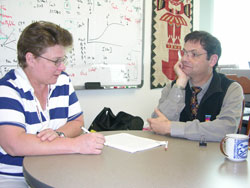 |
From left: Sandy Talbott, UNMC clinical research specialist, talks with Stephen Rennard, M.D., about the study that will evaluate effectiveness of vitamin A derivative in repairing lung damage of emphysema. Dr. Rennard will lead the study at UNMC. |
The phase II, two-year randomized double-blind study will be conducted in 30 centers with 500 study participants, and is funded by Roche Pharmaceuticals.
Stephen Rennard, M.D., UNMC Larson Professor of Medicine, is principal investigator for the study at UNMC. UNMC will recruit from 20 to 40 participants with emphysema, age 44 and older, who have been smoke-free for a year.
“It’s a very important study,” Dr. Rennard said. “If it works, this will be a completely new way to restore lung function in people with emphysema and offer them things that no other therapy today does short of transplantation.”
Retinoic acid has been found to stimulate growth of lung tissue in mouse models, even after the formation of emphysema.
Retinoic acid controls the formation of cells in the walls of the lungs and is present in the lungs before and after lung development, as well as through the formative years.
Dr. Rennard said the study is designed to evaluate the effects of retinoic acid on the retinoic acid receptor (RAR) gamma in the lung. There are two other RAR receptors: alpha and beta, which were thought to inhibit repair of cells.
Studies combining alpha, beta and gamma receptors have been limited and have not shown much success. Dr. Rennard said RAR gamma may be effective on its own.
“RAR gamma works through the pathways that vitamin A would work, but it’s more precise and potentially more specific,” Dr. Rennard said. “We might find this works on RAR gamma differently, which is why this becomes a very important experiment. If these various mechanisms can lead to the formation of new lung tissue, then maybe it could grow new lung tissue back where lung tissue has been destroyed.
“If this drug worked perfectly, you could restore lung function to 100 percent. Though that’s extremely unlikely, if this works, potentially it could restore lung function to maybe 40 percent. Going from 30 percent lung function to 40 percent could be very meaningful. It might make a difference between being able to walk up a half-flight of stairs with difficulty to walking up a full flight of stairs without much difficulty.”
The study also is important because it will explore new methods for evaluating people with emphysema, Dr. Rennard said.
“Even if the drug has a modest effect, the study design itself could be important in that researchers are exploring scientific territory previously unexplored,” he said.
The study also is unique in that it will use computed tomography scan (CT) to measure whether the drug improves emphysema in patients.
“Most lung studies rely on measuring lung function, which classically has been used for asthma, but doesn’t measure the effects of emphysema nearly as well,” Dr. Rennard said. “CT represents a new way of evaluating drug treatment for emphysema and can measure how much emphysema there is in the lung and if a drug makes a difference. This has not been used in the U.S. for the evaluation of a drug’s effect in emphysema.”
An estimated 2 million Americans have emphysema (about 25,000 Nebraskans), a disease that involves the destruction of healthy lung tissue, thereby constricting the airways.
Emphysema, most commonly caused by smoking, causes chronic obstructive pulmonary disease, which leads to obstructive airflow and an inability of the body to repair damaged lung tissue.
The most common problem for people with COPD is shortness of breath.
“Since they get short of breath with exertion, they stop exerting and restrict their activity,” Dr. Rennard said. “What goes along with that is predictable. People get depressed and have many other problems.”
Connie Gross of Earling, Iowa, is participating in the study in hopes that it will someday help her and others with the disease, which she says limits her activities.
She depends on oxygen provided through a portable oxygen tank she has with her at all times.
During the study, participants will make about 14 visits to UNMC for various tests, including lung function, blood and urine specimens, X-ray, CT scan and questionnaires.
Qualified study participants will receive a small stipend. A pill form of retinoic acid will be administered once a day in the control group.
Dr. Rennard, who is recognized internationally as an expert in COPD served as a consultant to Roche to help design the study. Dr. Rennard serves on the executive committee of the grant and is chair of the biomarkers committee responsible for evaluation of the biological responses of the drug.
For more information about the study, contact Sandy at 559-6365, 559-8245 or stalbott@unmc.edu.